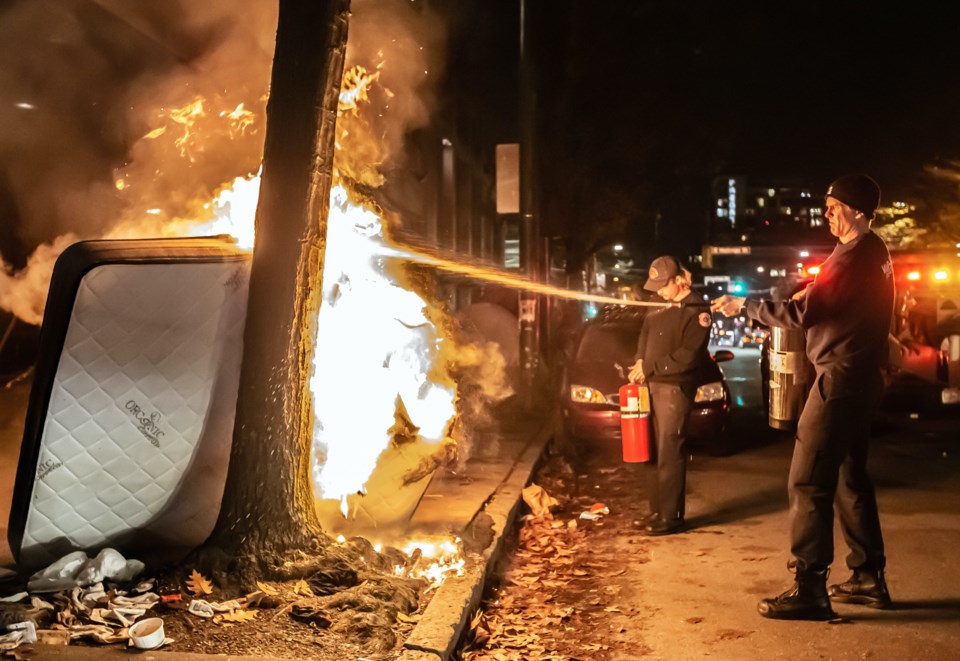A heavy-set man in his early 50s is slumped against a wall in the courtyard of the Overdose Prevention Society in the 100-block of East Hastings Street.
Multiple injections of naloxone fail to revive him.
Up the street and around the corner, a mattress propped up against a tree outside the former police station on Main Street is fully engulfed, shooting flames into the sky within plain view of a person tucked in a sleeping bag at the entrance of the building.
A man walks up to the bizarre scene to warm his hands.
The incidents happened almost simultaneously on what was a cool Friday night in the Downtown Eastside, where overdoses and fires continue to reach extraordinary numbers in what could be another record-setting year.
Seeing the tragedy and damage first-hand are firefighters.
More specifically, 14 of them working Nov. 25 out of the No. 2 fire hall at Main and Powell, a 1970s era station adjacent to a strip club and across the street from a government social assistance and employment office.
It is believed to be the busiest hall in B.C., if not Canada.
Last year, total calls reached 13,544.
This year, the tally going into the end of November is close to 12,000, with overdoses totalling 2,783 and fires pushing 900; six years ago, firefighters at No. 2 hall responded to 2,214 overdoses and 329 fires over the entire year.
Alarm calls last year reached 2,619 compared to 1,376 in 2016.
Known as “C shift” in the department’s rotation, the crew operating Friday is comprised of a captain, three lieutenants and 10 firefighters, all of whom can only work a maximum of 84 shifts before they are required to transfer to another hall.
That’s roughly the equivalent of a year.
Burnout is real in a neighbourhood synonymous with human tragedy.
“You can do 40 calls in a shift, whereas another hall in the city might have a shutout,” says Lt. Dave Hallgren in between runs on one of the hall’s two rescue-medic trucks.
“There's no comparison to this hall anywhere in the city, and even the types of calls. You can go to seven, eight overdoses in a row and some of those might be the same customer.”
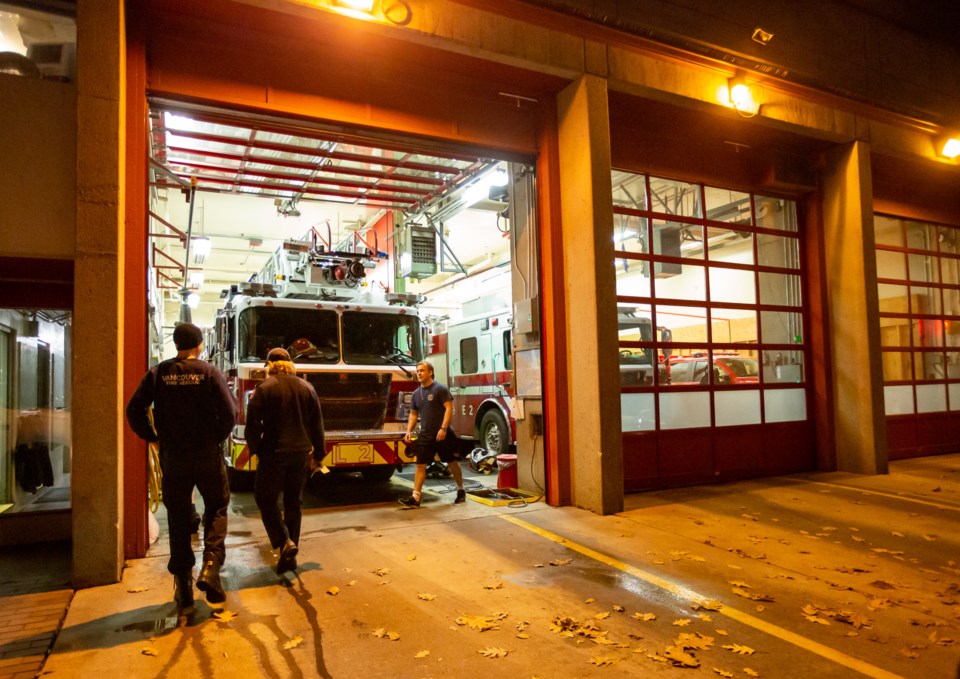
The Downtown Eastside, as has been well documented, is home to the city’s most vulnerable citizens, with poverty, drug addiction and mental illness at the root of street disorder and homelessness.
The pandemic has further exposed and exacerbated the misery.
A homeless encampment persists along the East Hastings strip, where violence, theft, and vandalism are part of daily life for many people living in tents and others who reside and work in the area.
More than 450 people in Vancouver died of an overdose in the first 10 months of the year.
The reason for the surge in fires — in single-room-occupancy hotels, in dumpsters, in alleys, in parks, on sidewalks, in tents and makeshift shelters — cannot entirely be explained.
But some of the causes include arson, smoking materials, people trying to keep warm, poor building maintenance and several incidents where lithium ion batteries from electric bikes exploded inside buildings.
Nine people died in fires this year, with five deaths linked to battery fires.
A fire order issued in July by Fire Chief Karen Fry to clear the sidewalks on East Hastings is still in place, although the strip continues to be populated with tents, despite outreach workers moving 45 people indoors and 150 structures being dismantled since mid-August.
It is against this challenging backdrop that firefighters at No. 2 fire hall began their shift last Friday morning, clocking in at 7 and working through the night until turning over the station to another crew 24 hours later.
By shift’s end, the 14 firefighters will answer more calls than many B.C. cities’ entire departments.
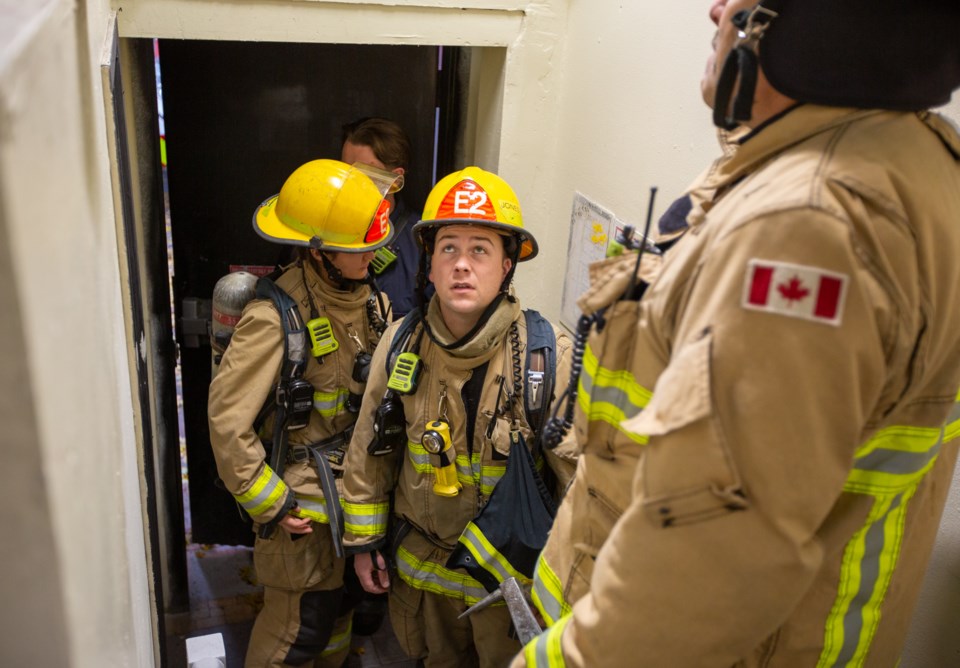
Hotel Persepolis
Capt. John McQuarrie and his team had already responded to two fires in an alley and one on a sidewalk when called at 10 a.m. to an alarm ringing at Hotel Persepolis at 351 Columbia St.
McQuarrie and firefighters Curtis Wilkinson, Paige Kulhanek and Carson Jones climb out of the Engine 2 pumper truck to search the rooming house for any sign of fire or smoke, but find none.
Inside, McQuarrie bangs on the manager’s door, but nobody answers.
“If he’s in there, he’s a good sleeper,” he says, standing in the hallway of the old building.
The room with the alarm panel is locked.
Firefighters can’t find anyone with a key, so they get a tenant to agree to sign an order to monitor the building for fire while efforts are made via the alarm company to reset the alarm.
Outside, McQuarrie has a discussion with Lt. Brian Dales about breaking down the door to access the alarm panel, which eventually happens and the alarm is reset.
McQuarrie was called to the Persepolis two weeks ago and discovered smoke in the basement.
After some investigation, firefighters determined the smoke was coming from a fire set in a water shut-off meter box on a nearby sidewalk. Someone had removed the metal grate covering the box to build a fire.
“They were sitting on these metal plates to keep warm, but all the smoke from the little fire the people made travelled into the building through the watermain,” he says.
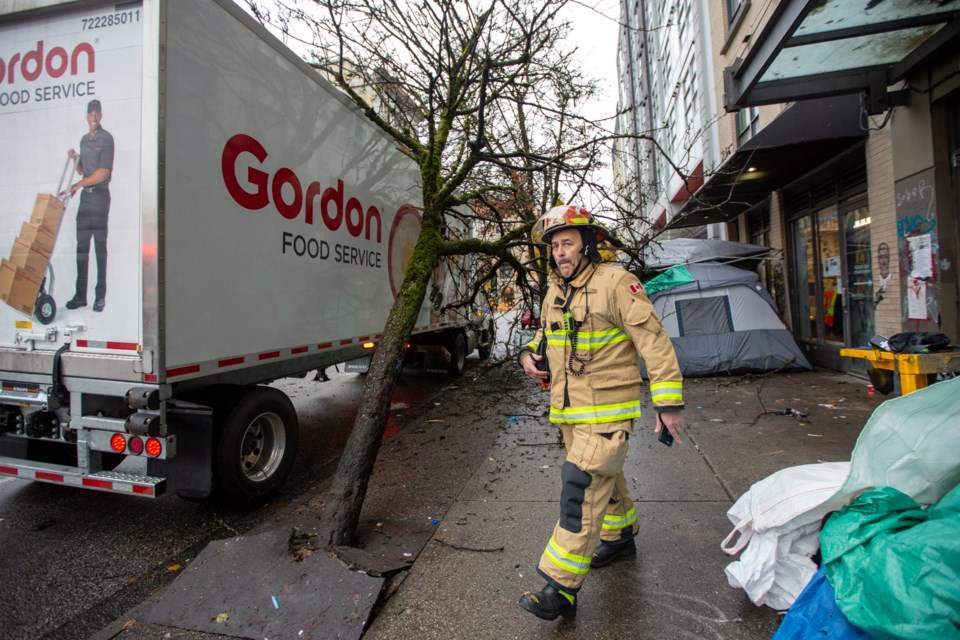
Truck uproots tree on East Hastings
After wrapping up the call, McQuarrie’s crew is alerted by a man to an incident around the corner on East Hastings Street, where a large food service delivery truck has clipped a tree and uprooted it from the sidewalk.
The tree’s branches are caught in bus trolley wires, which stopped the tree from falling onto a tent on the sidewalk. A transit supervisor and city crews are called while firefighters tape off the area and notify the tent’s occupant of the danger.
“Holy shit, bro — wow,” says the occupant, peering out of his tent.
The scene attracts a small crowd outside the Lux apartments, with some pedestrians ignoring the taped-off area and walking underneath the tree, despite calls from firefighters to avoid the dangerous mess.
McQuarrie and his team remain on scene until a city worker arrives and helps guide the driver and his truck out of harm’s way. The tree will be cut into pieces and the homeless man allowed to return to his tent.
McQuarrie, 52, has worked in all 20 of the city’s halls. And like his colleague, Lt. Hallgren, he says the experience in the Downtown Eastside — where he’s been stationed many times in his 23-year career — cannot be matched in any other part of Vancouver.
He described the work as “a good challenge.”
“It's busy, it’s always different, there’s a variety of calls, and it’s good for your skills,” he says, standing on the sidewalk before pulling himself up into the passenger’s seat of the truck. “I like being busy, so it's a good fit for me.”
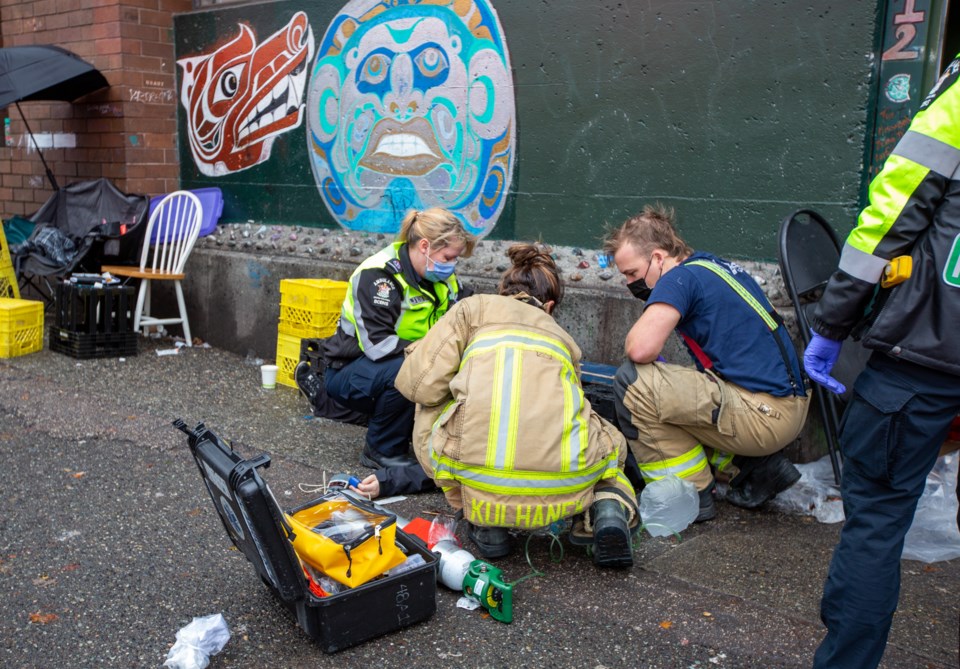
'Sad to see something like that'
That busyness continues while returning to the hall.
Engine 2 is dispatched to an overdose in the 400-block of East Cordova, across the street from Oppenheimer Park.
A young woman is unconscious on the sidewalk.
It’s just before noon, and two days after “cheque day,” which the BC Coroners Service has identified as a week where people who rely on social assistance money are more likely to die of an overdose than in other weeks.
Kulhanek and Jones work with a paramedic to help revive the woman, as McQuarrie stands back and explains the medical intervention taking place.
A pulse oximeter is clipped to one of the woman’s fingers to measure the oxygen saturation in her blood and monitor her pulse. A breathing tube is inserted into her mouth, followed by a bag valve mask to guide a high level of oxygen into her lungs.
“If I had to guess, her respirations are probably down to five a minute, which is fairly standard,” McQuarrie says. “If there has been any naloxone administered, quite often it takes a while or a couple of doses to take effect on her.”
Within minutes of making that comment, the woman regains consciousness. She is helped up and begins to cry. A couple of people on the sidewalk clap in appreciation of the work done by firefighters and paramedics.
The woman embraces a friend before she is escorted into an ambulance.
Back at the hall, Jones is asked about the call. He’s been on the job for less than two years.
Raised in Vancouver, he’s familiar with the city’s overdose crisis and the realities of the Downtown Eastside.
"It's definitely sad to see something like that,” says Jones, acknowledging the satisfaction of helping a person who could have died. “I want these people to get help, to feel better.”
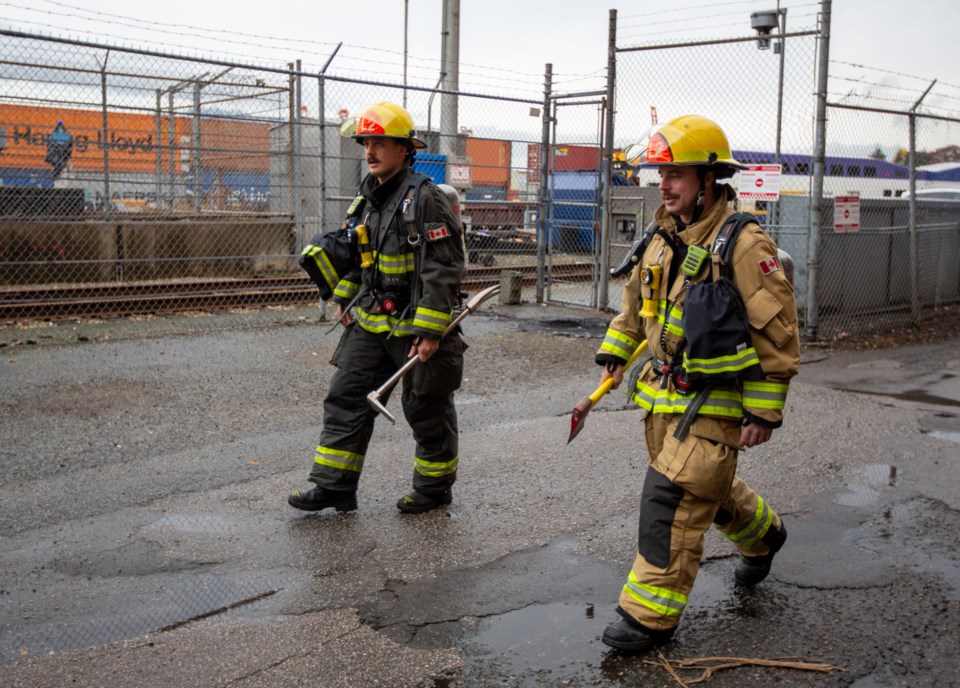
'Separate yourself from the call'
His answer opens up further discussion with colleague Adam Bordignon about the toll responding to repeated overdoses can have on a firefighter. Bordignon will soon reach his fifth-year anniversary and sees overdoses as a constant of the job.
His focus on such calls is clinical, not emotional.
“You come to work, [emergency] tones go, we’ve got an overdose and boom — let's get the [breathing tube in] and let's breathe for him,” he says. “Oh, he's alive, he’s got a heart rate, he’s breathing, Narcan in, he’s up — great. It’s not like it’s scary, it’s just ‘let’s go do it and do the best we can.’”
Jones says he has learned from senior firefighters not to carry every call with him.
“You’ve got to separate yourself from the call and realize you're just there to help,” he says. “I didn't cause [overdoses] to happen, but any little thing I can do to help people down here is all I can do.”
Adds Jones: “My girlfriend says the same thing: ‘How can you guys just [put the call aside]?’ But it's bad on your mental health to carry every call and just sit there and dwell. Luckily Vancouver and most departments have a lot of help for their firefighters.”
Before he can elaborate, the tones go off in the hall and Jones and Bordignon are off to an alarm call at a building in the 600-block Seymour Street; someone had inexplicably pulled the fire alarm, which is a common occurrence but requires firefighters to respond.
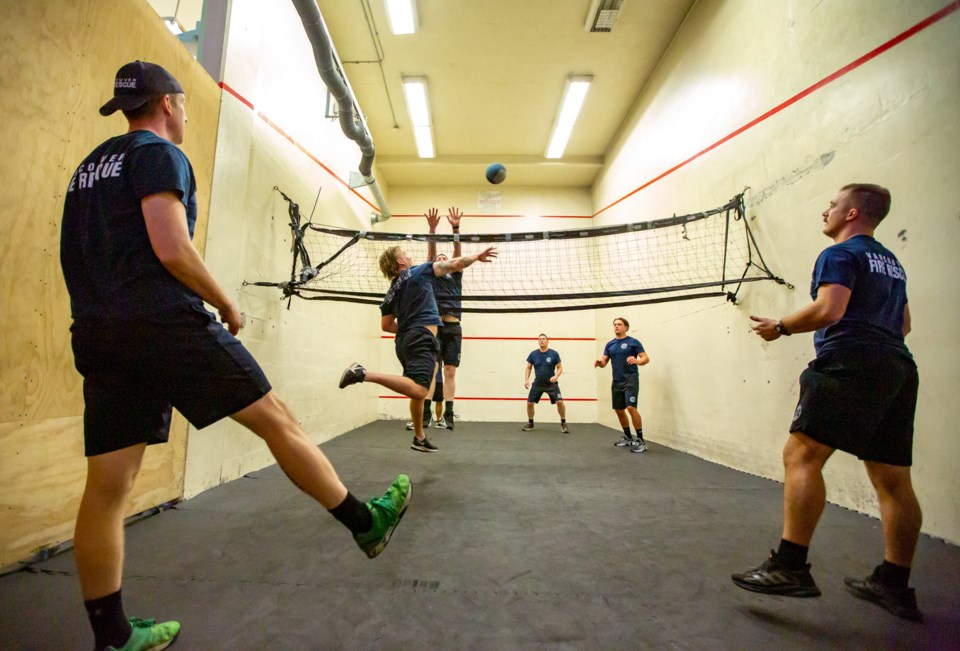
'That's a big part of how we decompress'
When the pair returns, they and most of the crew change into shorts and T-shirts to play a game they call “walleyball,” which is similar to volleyball except with a heavier ball that remains in play when batted or kicked at a wall.
It is a high-energy example of the camaraderie between the crew and a way to blow off steam and stress of the job.
That bonding exercise is extended to the kitchen, where meals are prepared together: for lunch Friday, it was burritos and tater tots; dinner was chicken burgers, salad and fries.
The banter is light, the laughs frequent.
A big screen television is on mute and tuned to a sports channel.
That togetherness was suspended when the pandemic was declared in March 2020, a time Andrea Lashin recalls all too well, having started her first shift as a firefighter on March 13 of that year.
“The first day in the hall was the day the pandemic was announced,” says Lashin after returning from two medical calls at a single-room-occupancy hotel on East Hastings.
“It was a weird time because nobody knew what to do back then. Regulations were always changing. Everyone was separated from each other, and that's a big part of how we decompress — we play games together, we work out together, we play sports together.”
She’s nine months into her rotation in the Downtown Eastside, having transferred from No. 22 hall in Marpole, where many calls involved falls, people experiencing chest pain and fires to homes and industry.
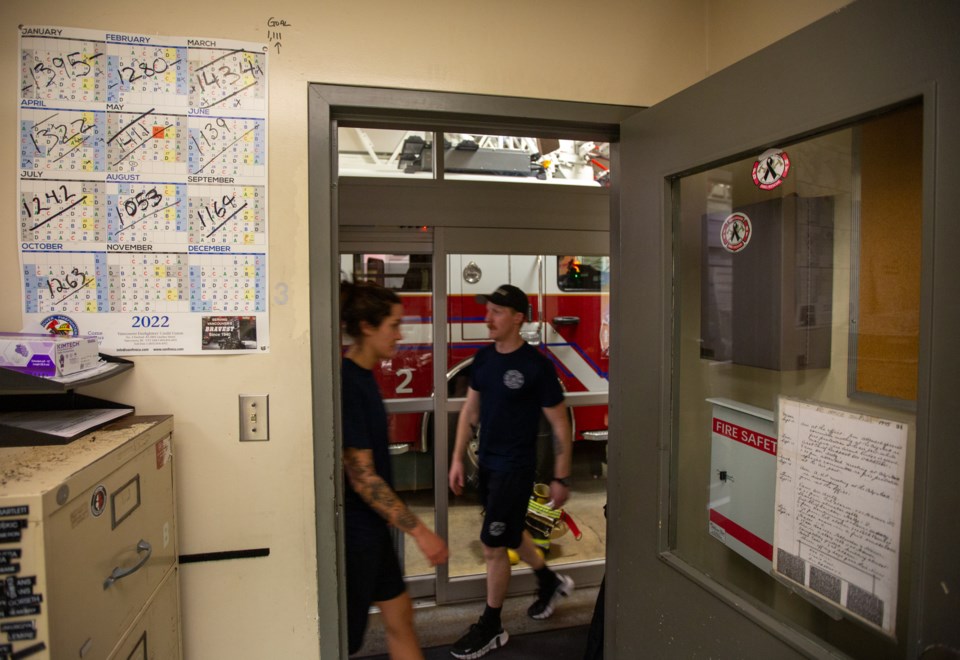
Tires slashed, canopy smashed
The pace at No. 2 hall has Lashin regularly catching up on sleep on her days off. It’s not uncommon, she says, to attend 10 or more calls after midnight, causing her heart rate to go up and down throughout the shift.
“Long term, it’s not beneficial to your health,” she says. “Here, it’s more volume, it’s more risk, there's lots of needles, you hear about the violence. You just really have to be on high alert and watch your safety.”
In recent weeks, one of the hall’s rescue-medic trucks parked outside the hall had its tires slashed and canopy smashed. Firefighters’ personal vehicles have also been vandalized, despite a fence being put up a few years ago.
A security guard now patrols the area outside the hall.
During one call earlier in the day, someone tossed an unknown object at the hall’s ladder truck as it travelled down East Hastings to an alarm call. That same truck responded to the Winters Hotel fire in Gastown earlier this year, where two people died.
Lashin was part of the fire attack team on that day in April.
“Half the building was already on fire when we arrived,” she says. “We got a lot of people out. We did what we were trained to do. Bad things are always going to happen, but you at least try to make it better.”
Lashin, 30, is the first person in her family to become a firefighter.
Why not become a police officer, or a paramedic or do some other job?
“I feel like I’m in my interview again,” she answers, laughing before she continues with her response.
“It’s lots of things. I like the physical and mental challenge of the job. You’re learning something new every day. I like the camaraderie, the teamwork, the fun we have together. And I'm helping people. I feel a lot of pride in the work I do.”
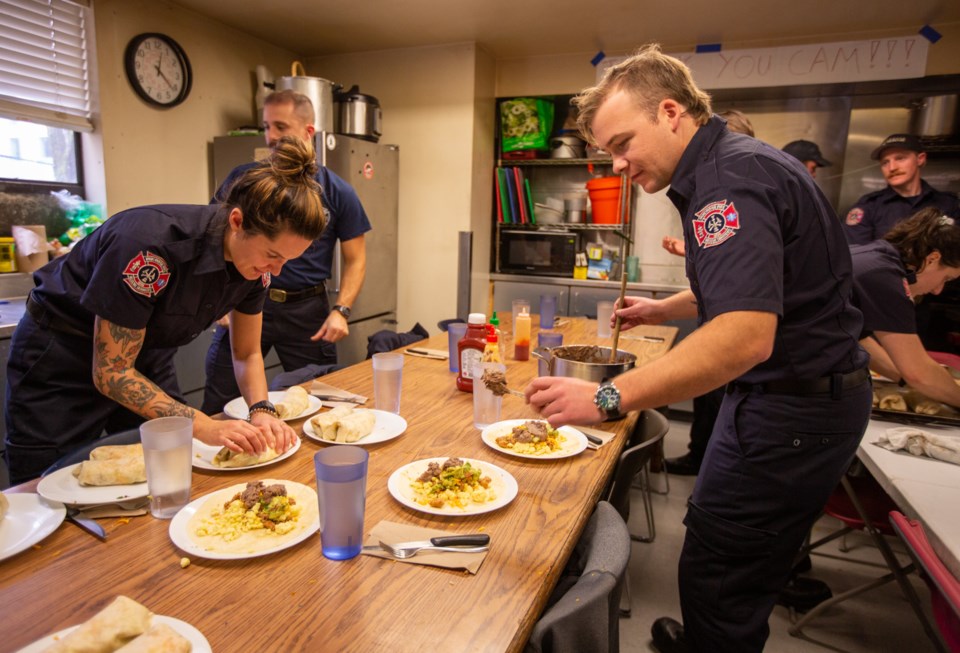
'You can't have a fire in a tent'
As the afternoon turns into early evening, a flurry of calls comes into the station.
Another alarm ringing at a building, another overdose near Oppenheimer Park and a report of a tent fire on East Hastings send crews into the night, with lights flashing and sirens blaring.
The tent, it turns out, wasn’t on fire but the man living in it started a small fire in a cast iron pan. He told firefighters he was cooking bacon, although the pan was filled with cardboard and paper.
“You can’t have a fire in a tent,” McQuarrie tells the man.
“Not even a candle?” he replies.
“Not even a candle,” McQuarrie says.
Jones pours water in the pan to ensure its contents are no longer flammable. As he buckles himself in after getting in the truck, Jones says he feels bad about having to extinguish the man’s heat source.
“It gets cold out there, but it had to be done,” he says.
As Chief Fry outlined in her order and in a news conference in August, the danger is real for the man and others living on the East Hastings strip, where many tents and structures are attached or within a few feet of each other.
124 tents, structures remain
Firefighters have managed to clear 21 spots of concern along the strip, but a city communications representative said in an email Monday that approximately 124 tents and structures remain between Abbott and Gore streets.
The tents and the people living in them also present another challenge for firefighters when responding to a “man down” call, as Lt. Reg Landles explains.
Sadly, so many people fit that description.
“We'll get a call at Columbia and Hastings, with no particular address,” Landles says. “What we're looking for going down Hastings Street is someone waving us down because we're not exactly sure out of the 10 people that are laying down who needs the help first. That's a reality.”
That scenario almost plays out when Landles and firefighters Cam Galbraith and Josh Wyer respond to an overdose on a sidewalk in the 300-block Powell Street.
The trio was originally dispatched to a call for a 58-year-old man experiencing chest pains in the same block. As they drive to the address, a crowd on a sidewalk waves them down.
With paramedics attending the chest pain call, the medic-rescue team circles the block and returns to treat the young man who overdosed. Galbraith and Wyer repeat the same process that Kulhanek and Jones did earlier in the day on the woman who overdosed up the block.
The man comes around and firefighters leave him with paramedics.
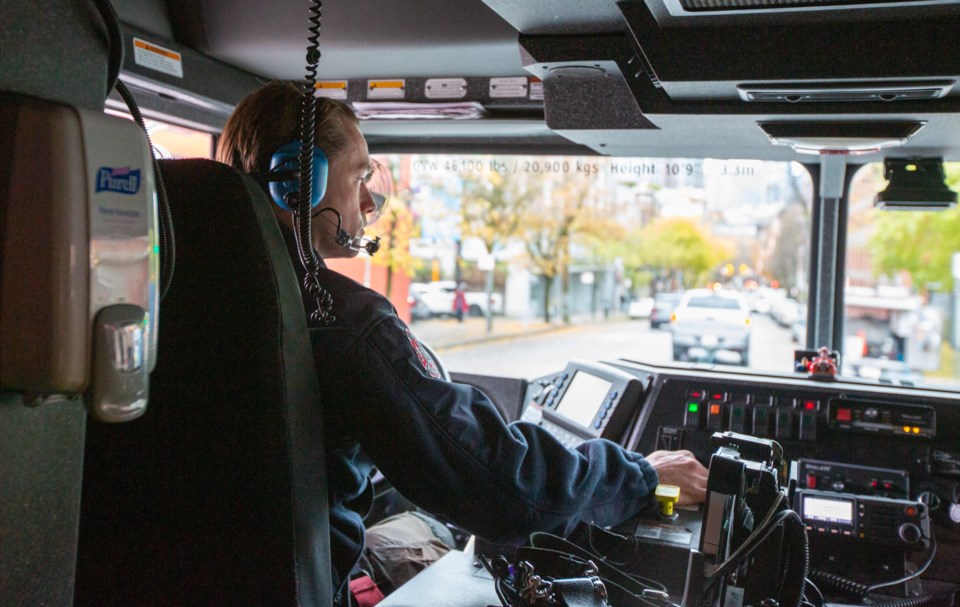
'That's why we had to break down the door'
Just after 8 p.m. another alarm call comes in.
It’s for the Hotel Persepolis again.
When McQuarrie’s crew arrives, the manager is there this time and firefighters reset the alarm, which was caused by someone smoking on the third floor — the same cause of the morning alarm.
He shares later that firefighters learned in the morning run that the door to the fire panel room was purposely fortified from inside.
“The guys [the manager] left in charge decided to barricade themselves in the basement by putting a board against the door and kept doing the drugs they were doing downstairs,” he says. “That's why we had to break down the door.”
Back at the hall, McQuarrie enters information into a computer about the hotel, noting he can’t think of a shift over the past two weeks where he hasn’t been called to the Persepolis.
He suspects the department’s fire wardens will follow up with the owner to get the alarm system serviced, have a full inspection done of the building and ensure emergency lights work and there are no blocked exits.
“That would be a terrible place for a fire,” says McQuarrie, noting a fire attack would largely be via ladders to the building’s windows. “If the primary exit gets blocked or you get stuck in there, there’s no other way out.”
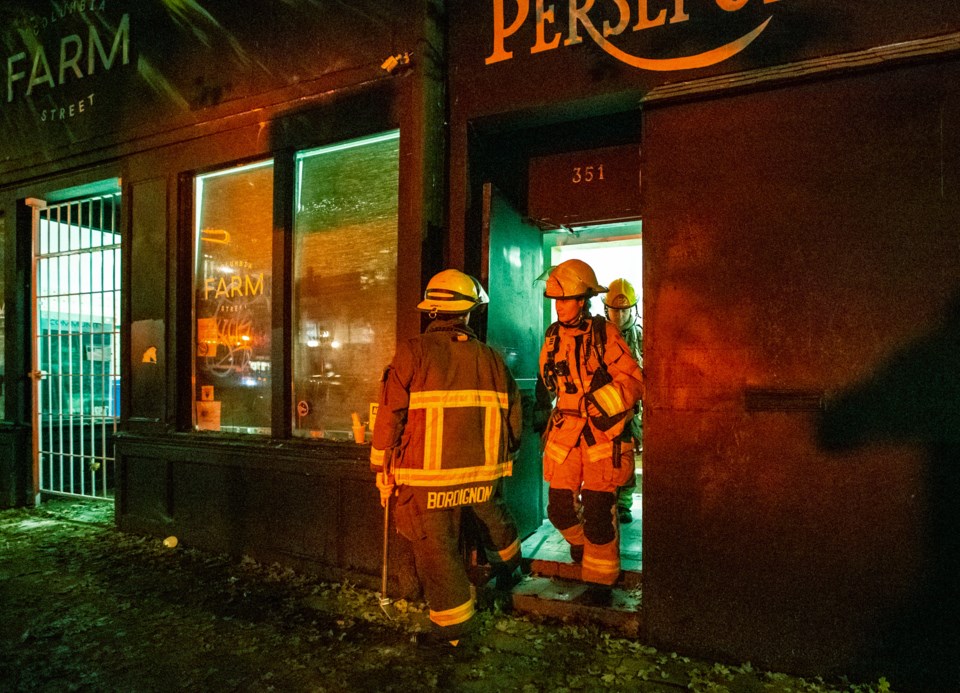
Multiple naloxone injections
The emergency tones go off again.
It’s another overdose.
Landles, Galbraith and Wyer get in the rescue-medic truck, drive up to the intersection of Main and East Hastings, where a police officer activates the lights in his cruiser to assist in clearing a route for the crew.
They pull up to the front door of the Overdose Prevention Society at 141 East Hastings, where the sidewalk is active with people, some in tents, some passed out in plain view and a couple men are seated on chairs nodding to music from a portable stereo.
Inside, firefighters are led by staff to a heavy-set man slumped against a wall in the building’s courtyard.
His name is Brent.
He’s in a black T-shirt, jeans and white high-cut Nikes.
Galbraith and Wyer are told he has been injected with naloxone. A breathing tube and oxygen are used in an attempt to revive him. An ice pack is tucked under his shirt near his armpit, which gets a brief reaction from him.
Paramedics arrive, more naloxone is administered.
Landles loudly calls out to the man several times.
“C’mon brother, you’ve got to help us here,” he says.
No response.
A decision is made to transport him in an ambulance to hospital.
Outside, a man in the street gives Galbraith the patient's full name and age before approaching the stretcher and telling his friend he’s going to be fine.
Still no response.
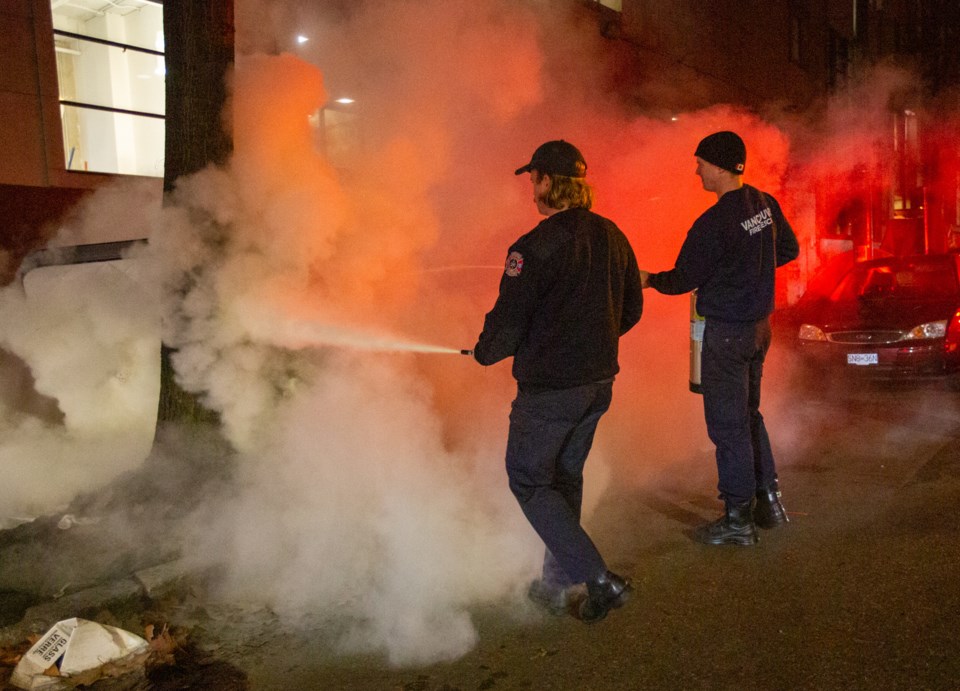
'Whatever we get, we just do the job'
Inside the medic-truck, the firefighters discuss the call and suspect the man had benzodiazepines in his system, which don’t respond to naloxone.
“Those benzos just keep a person down,” Wyer says.
Landles adds that even with medical intervention, it is unknown how successful the patient’s recovery will be and whether he will experience life-altering effects from the overdose.
Landles begins to elaborate when Wyer interrupts: “We’ve got a fire across the street.”
A mattress propped up against a tree is ablaze in front of the former police station in the 300-block of Main Street.
Landles calls it in to dispatch while Wyer and Galbraith hurry to the back of the truck’s canopy to grab extinguishers.
A man approaches the bizarre scene to warm his hands.
“You want to step back sir,” says Wyer, before he and Galbraith knock down the flames within seconds.
A person tucked in a sleeping bag at the entrance of the former police station takes it all in before No. 2 hall’s ladder truck arrives to fully soak the mattress so it can’t be ignited again.
“This is not normally what we would do, but we could get to it quickly enough and get something on it,” says Landles, noting the limitations of being in a pick-up truck versus a large firetruck equipped with hoses and water.
'No rhyme or reason'
It’s now just after 10 p.m. and the 14 firefighters at the hall have responded to 36 calls since 7 a.m. They will go on to answer another 22 calls before shift change, for a total of 58 in 24 hours.
Over the same time period, firefighters at Victoria’s three fire halls will respond to 35 calls. In Coquitlam, that city's four halls will answer 32 calls. In Richmond, it will be 37 across seven halls.
For McQuarrie, who assessed last Friday’s shift in a later interview, the call load and type answered were not atypical for the hall.
“It was a little busier, but not much,” he says, adding that day of the week doesn’t factor in volume of calls.
“There’s no rhyme or reason. A Tuesday could be the busiest night, and you come in on a Saturday and it could be the quietest night. Whatever we get, we just do the job.”
@Howellings
